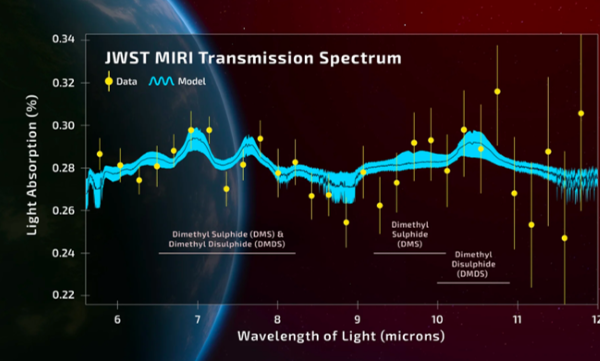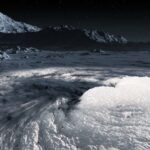Hycean worlds are sub-Neptune-size water worlds with thick atmospheres. Often described as Super Earths, they are among the most studied and discovered exoplanets. Many have been found in the habitable Goldilocks zone circling their parent stars. More than a dozen identified to date circle M dwarf stars, and one of them, called K2-18b, made NASA headlines and the talk show circuit in the past week.
K2-18b is 124 light-years from Earth. It is being studied using the James Webb Space Telescope (JWST). Spectroscopic readings show an atmosphere containing carbon molecules including methane (CH4) and carbon dioxide (CO2), and hydrogen (H2) with water vapour (H2O) present.
Hydrogen-rich atmospheres aren’t indicators that life is present. Neptune has an atmosphere largely made up of hydrogen, and there is nothing to suggest life exists on that ice giant. The presence of CO2 and the absence of ammonia (NH3) and carbon monoxide (CO), however, and the location of K2-18b within its star’s Goldilocks Zone make this planet study worthy.
The Astrophysical Journal Letters published an article on April 17, 2025, describing research results based on JWST spectroscopic analysis of K2-18b. The article written by researchers from the University of Cambridge, Cardiff University and the University of Birmingham in the United Kingdom, and those from the Space Telescope Science Institute and the Space Science Institute in the United States, indicated (see graph below) other gasses present, dimethyl sulfide (DMS) and dimethyl disulfide (DMDS), showing a high abundance for both.

The detected CH4 and CO2 made K2-18b interesting to study because these two gasses can come from biological sources. They can also come from inorganic materials. On the other hand, DMS and DMDS are entirely different issues. DMS on Earth is exclusively a byproduct of microscopic algae. DMDS has microbiological origins as well as being a gas emitted by garlic, onions, cabbage, kohlrabi and some animals.
Could there be another explanation?
Could gasses associated with organics be produced by inorganic sources. Certainly this is the case with CH4 which can have abiotic sources.
The only occurrence of abiotic DMS found so far comes from analysis of the composition of the comet Chuyumov-Gerasimenko, a Jupiter-family comet visited in 2014 by the European Space Agency’s Rosetta mission. Analysis of the makeup of the comet indicated DMDS was present. How it got there was unknown. Could other comets also have DMS present? In that case, could a comet have brought DMS to K2-18b? That doesn’t explain the presence of DMDS, nor does it account for what would happen to DMS during a comet’s hypervelocity impact with a planet.
Another interesting observation noted that on Earth, atmospheric DMS is found in small amounts even though it continuously gets produced by microalgae. It appears not to have a long atmospheric shelf life. On K2-18b, however, the DMS readings indicate a much greater presence. What would account for this, and DMDS existing in greater abundance on this Hycean planet?
The paper’s authors conclude only one thing: that K2-18b harbours a biogenic ocean, implying strong biological activity on the planet. States Nikku Madhusudhan, from the Cambridge University Institute of Astronomy, “Decades from now, we may look back at this point in time and recognize it was when the living universe came within reach…where suddenly the fundamental question of whether we’re alone in the Universe is one we’re capable of answering.” That’s because, states Madhusudhan, “Given everything we know about this planet, a Hycean world with an ocean that is teeming with life is the scenario that best fits the data we have.”
We won’t be capable of visiting K2-18b for many centuries, being so far away from us. But at some point, when our technology can transport us across light-years, we may finally get to see for ourselves what is in the oceans and atmosphere of K2-18b.
No doubt, in the interim, astronomers will be doubling down on studying Hycean worlds while we continue to look for life locally in our Solar System by roaming the surface of Mars and sending robotic spacecraft to hycean moons like Europa and Enceladus.









